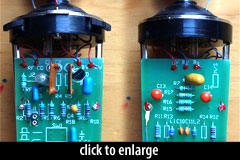 Audix CX-111
Audix CX-111
Cardioid Condenser Microphone
The CX-111 was one of Audix’ first large-diaphragm condenser mics, released in 1998. It is a large diaphragm mic with a transformer-coupled output circuit, switchable pad and filter.
It is similar to the CX-101, which had the same capsule (according to Audix) and presumably a similar circuit, without the two switches.
The capsule in both mics was a single-sided K67 type with a 33mm outside diameter.
The CX-111, unlike the CX-101 or CX-112, had a distinctive perforated grille rather than the more traditional metal mesh. Alhough this probably affected the high-frequency response of the mic, the published frequency graphs for the CX-111 and CX-101 were identical.
 The CX-111 circuit bears many similarities to other transformer-coupled mics of the day, including the MXL 2001 and ADK A-51.
The CX-111 circuit bears many similarities to other transformer-coupled mics of the day, including the MXL 2001 and ADK A-51.
It appears to use the same 2-stage transistor circuit, presumably with negative feedback to apply corrective EQ to the K67 capsule. This would give the mic a more neutral high-frequency response, unlike many of the low-cost transformerless mics that have been made since.
CX-111 PCB photos: Nick Cara
Cliff Castle, Audix, 1998
We anticipate a strong demand for this product for both studio and live broadcast applications. We’re aiming not only at the home and project studios ready to upgrade their mics, but also at larger studios that never have enough good-sounding, large-capsule mics.
Permalink: Audix CX-111
The mic was released in 1998.
Specifications
| Pickup Patterns | Pads & Filters |
|---|---|
|
Cardioid
(16.5 mV/Pa; 20 - 20,000 Hz) |
|
| Capsule Dimensions | Impedance | SPL/Noise |
|---|---|---|
| Diaphragm diameter: 25mm Capsule diameter: 33mm |
200 Ohms (Low) | Max SPL: 145 dB Self-noise: 17.0 dB(A) |
| Weight | Length | Max Diameter | Interface(s) |
|---|---|---|---|
| 482g (17.00oz) | n/a | n/a |
|
| Power Specifications |
|---|
|
Did we get anything wrong on this page? Please let us know!



